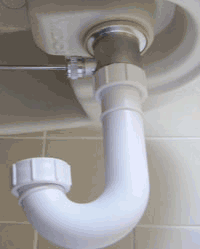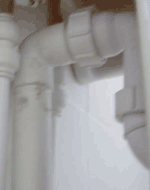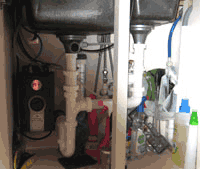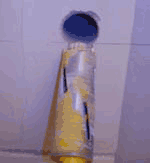Fitting waste pipes to sinks and basins is often the hardest part of plumbing in a kitchen and likewise fitting waste to baths and showers in a bathroom. First you have to figure out where you are going to run the waste for the washing machine and dishwasher, bath, basin etc. and if they are going to be included in the under sink waste system. Then it’s the problem with drilling through the wall with the right equipment and in the right place. Then it’s the problem of what and where to connect to when it is outside.
The two pages of this project will show you firstly in this page, how to connect your waste pipe under the sink or basin, then what to do and where to take it in the second page.
Not every home is the same of course but using these guidelines you should be able to work out where to site your waste.
Firstly its important to know why you need to fit the waste pipe the way you do. This can be seen in our project on how waste traps work.
Types of Waste Pipe Trap and Fitting Them
There are a number of different types of waste trap and you can find out here if you have the right one. The waste traps shown in the images below are P traps and they are one of the most commonly used under kitchen sinks.

Half of a P trap

Complete P trap
Usually, when buying a kitchen sink it comes with a waste kit. There will be parts of this kit which can be fitted into your undersink waste system which will allow you to connect a washing machine, dishwasher or both directly to the pipework. These fittings are called appliance fittings and are very handy if space is tight and if you can get your machines close enough to the sink waste.
If you cannot you will need to deal with waste from them separately and this is covered in our washing machines and dishwasher plumbing project.
P trap wastes, such as the one shown above, usually come in two parts. It’s a great idea, in most circumstances, if you can get the down pipe back against or close to the wall.
There is never much room in kitchen cupboards or behind baths and sinks so keeping it out of the way is a good idea. There are usually enough parts in the waste kit to achieve this but if not you can buy every conceivable waste from your local DIY store just in case you have to change plans quickly.
You can see from the image below we have extended our waste and got the down pipe back to the wall. There is also the option of taking the P trap outlet straight outside, but in most cases these days people have 1½ bowl sinks which makes the waste pipe adaptation a little more difficult.

Under the kitchen sink image
The image above it shows how a 1½ bowl waste fits together. In this case we have put the P trap at the bottom so it can run straight out of the wall. You can see the mixture of fixtures and fittings we have used here to get to where we needed to be and this is an important point. There are no rules! As long as the pieces you fit together, do actually fit together, and do not leak, it is acceptable.
If there is a blockage in any part of this pipework, disconnecting the pipes at the sink will be sufficient to unblock it. Most of the waste pipe systems under a sink are screwed together so are not difficult to undo.
It’s only when we start dealing with push fit and solvent welding it becomes really important to keep access in mind in case of blockage. Using a sink strainer will help avoid food waste going down the plug hole and causing blockages.
Drilling Through a Wall to Fit a Waste
Now it’s time to mark and drill the wall. We do not recommend any other way other than to hire a strong electric drill for the day, together with a diamond core 50mm drill bit. These two pieces of apparatus will have the hole drilled in under 5 minutes whereas you could be messing around all day trying to knock a hole with a hammer and chisel.

Drill through the wall
Obviously you will need to cut a hole in the back of the unit if needed in order to get at the wall and we suggest using a hole saw for that. A 100mm timber hole saw will give you plenty of room to get the 50mm drill bit through afterwards.
When you hire the diamond core bit you will need an arbor. The arbor connects the drill bit to the drill as core bits have no shaft which can be placed in the drill chuck. You will also need an extension piece to allow you to drill through the full thickness of your wall.
When drilling do not push the drill hard as you go through the wall. Diamond tipped bits will cut through most materials easily and when you get close to the outside face of the brickwork you should be very gentle otherwise you could blow the face off the brick as the drill goes through.
Push the pipe through the wall when you have made the hole, connect it to your waste inside, then go outside and mark the wall face on the pipe with a pencil, then take the pipe out again. It’s now time to move on to part 2 of this project, click the link below.

